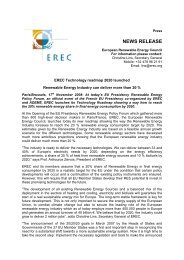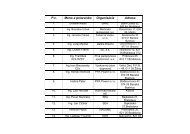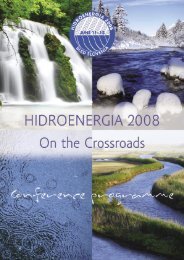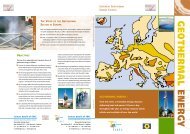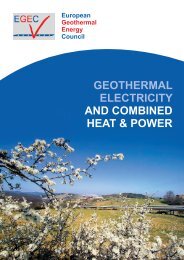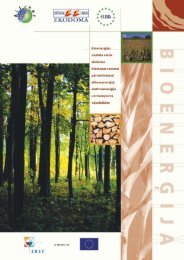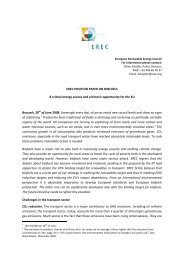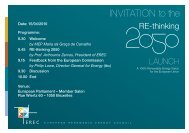Sardinia - European Renewable Energy Council
Sardinia - European Renewable Energy Council
Sardinia - European Renewable Energy Council
Create successful ePaper yourself
Turn your PDF publications into a flip-book with our unique Google optimized e-Paper software.
<strong>European</strong> RE - islands<br />
RES<br />
<strong>Renewable</strong> Energies in <strong>Sardinia</strong>
Regional Context<br />
<strong>Sardinia</strong> island is an Italian region with a special autonomy in the national system, close to Corsica<br />
French island, between Italian peninsula and Spain.<br />
Island main data 24.090 km2<br />
1.648.000 inhabitants<br />
376 Towns<br />
335 with less than 3.000 inhabitants<br />
which, for their dimension and for their distribution in the territory, ritory, highlight the historical and<br />
cultural basic structure of the island.<br />
It preserve an environmental patrimony in the internal and seaboards ards areas of very high quality.<br />
Average 15.000 € inhab/ year, but lucky for the good climate and a rather good<br />
quality of life.
Not so lucky about energy autonomy, and that can be a problem for r the future.<br />
• Nationals and transactional gas and electric grids connection: the t<br />
island is not connected.<br />
• <strong>Energy</strong> dependence<br />
Actual Power Installed<br />
-OIL<br />
94% from abroad<br />
-RES<br />
2% local<br />
-Solid fuel 4% local<br />
3000 MW<br />
Urgent a new approach in the energy management system, a special opportunity for the island to improve<br />
• A direct role (not only external enterprise)<br />
• Direction of technology<br />
• Local resource development<br />
• <strong>Energy</strong> Security supply<br />
• Lower Costs of local productions
A new role for the island in the framework of the actual transformations rmations in the sector:<br />
• energy sources diversifications<br />
• market liberalisation<br />
• energy saving<br />
• energy efficiency<br />
• renewable energies applications development.<br />
This is the new phase <strong>Sardinia</strong> island is beginning to look for.<br />
RE Islands project co-financed by the Commission have been a useful tool to sensitize institutions<br />
and local enterprises on situations and perspectives of renewable e energies in <strong>Sardinia</strong>.
Wind <strong>Energy</strong> on-shore<br />
Wind energy development in <strong>Sardinia</strong> is very recent, as well as the t<br />
others sources of<br />
renewable energy, except for hydroelectric. <strong>Sardinia</strong> can be considered a favoured isle for<br />
wind energy development and has big potentialities. Actually wind d plants working are:<br />
– Wind parks n° 15<br />
– Installed power<br />
MW 272<br />
– Electric energy produced (average per year)<br />
MW/h 686.157<br />
with an installed power for single plant which varies from 0,75 MW to 1,5 MW.<br />
For the next future and for the prospective the interest of the industry is very high, and that<br />
is confirmed from installation requests arrived at single communities and at the <strong>Sardinia</strong><br />
Regional office.
Wind parks requests arrived MW 3.500<br />
In fact in next five years will be concretely possible to realise e about 500 MW, considering the<br />
necessity to realise the environmental evaluation and the industrial plans. This data shows the<br />
Industrial importance and the economic value of business and investments in the sector.<br />
MW<br />
3500<br />
3000<br />
2500<br />
2000<br />
1500<br />
1000<br />
500<br />
0<br />
Actual<br />
Potentiality<br />
Next five years
Companies interested<br />
Wind energy potential in <strong>Sardinia</strong> provoked the interest of different companies operating in the<br />
sector. Some of them have the seat in Italy and in others <strong>European</strong> countries. Actually there are<br />
principally operating in <strong>Sardinia</strong> n° 4 companies.<br />
It is expected that wind energy development will establish new companies c<br />
and new organisations.<br />
In that sense Re - Islands project can give an important contribute, on the information and<br />
dissemination level, and development and organisation as well.
Wind energy off-shore<br />
Actually in <strong>Sardinia</strong> does not exist off-shore wind plants. In the recent past have been activated<br />
some studies with a preliminary character, with the objective of the potentialities and possibilities<br />
evaluation.<br />
For the off-shore wind plants realisation and their visual impact , it must be considered the tourist<br />
strong vocation of the island and also the caution of the planning ng regional legislation. Nevertheless<br />
does exist concrete potentialities, both for the wind quality and d for water depth, in the west part of<br />
the island overall.
Thermal Solar <strong>Energy</strong><br />
Solar <strong>Energy</strong><br />
In the case of <strong>Sardinia</strong>, which is a Mediterranean country predestined for the use of solar energy,<br />
the number of solar water heating systems collectors is lower than the <strong>European</strong> average. The use<br />
of solar collectors increases very slowly. The total amount of solar s<br />
collectors installed is:<br />
6.600 m2 and corresponds to 4 m2 per 1.000 inhabitants<br />
Compared to average figures in the Mediterranean countries and considering c<br />
the favourable<br />
climatic conditions of the islands it demonstrates that the poor market development of solar<br />
collectors in <strong>Sardinia</strong> needs a strong campaign for promotion and diffusion.<br />
A promotional campaign was launched last year, targeted to local communities and authorities.<br />
A new campaign will be launched next year addressed to the camping sites.
The aim is to install solar collectors up to 20 m2 / 1.000 inhabitants itants (in 2010). This effort permits<br />
<strong>Sardinia</strong> region to reduce the big difference with <strong>European</strong> and Mediterranean M<br />
regions. In that new<br />
situation an amount of 20,6 GW/h solar energy can be earned and an equivalent electricity<br />
production from fossil fuels of 52,8 GW/h, actually used from warm water preparation, can be<br />
saved.<br />
200000<br />
m2<br />
150000<br />
100000<br />
50000<br />
Actual<br />
Potentiality<br />
Next five years<br />
0
Photovoltaic Solar <strong>Energy</strong><br />
PV plants installed in <strong>Sardinia</strong> are very few even though the enormous potentiality of the island.<br />
Solar radiation value is average from 1.600 kW/h/m2 to 1.700 Kw/h/m2 per year.<br />
PV power installed<br />
1.000 kW<br />
These few plants are prevalently installed in the little island of Carloforte, , south-west of <strong>Sardinia</strong>,<br />
600 kW and the other 400 kW are related to plants installed in Alta A<br />
Nurra, , north-west, 100 kW in<br />
scholastic institute and universities.
Considering the extraordinary potentialities related to the favourable climatic conditions almost all<br />
over the years, the sector needs a strong impulse through campaign aimed to inform consumers<br />
and public institutions on some essential data:<br />
• national, regional and U. E. support for PV plants applications;<br />
• advantage related to electric energy production from PV plants and a<br />
possibilities of its<br />
introduction in electric national grid;<br />
• the opportunity of realisation of PV plants to supply rural farms s which can not be<br />
connected to the electric grid for economic reason and can not by supplied by other<br />
sources.
Es.: 3000 rural farms are not connected to regional electric grid. g<br />
Their operativity is essential for<br />
local economy and employment. The average power for each farm will be 4 kW and<br />
consequently the minimum power to install is P = 12 MW PV<br />
PV energy in <strong>Sardinia</strong> seems to be:<br />
A necessity<br />
- not grid connected entities<br />
An opportunity<br />
- new technologies<br />
- energy saving<br />
- electricity production (0,45 €/kWh x 20 years)<br />
support<br />
100<br />
80<br />
MW<br />
60<br />
40<br />
20<br />
0<br />
Actual<br />
Potentiality<br />
Next five years
Ocean/Wave/Tidal energy<br />
Actions for the utilisation of wave-tidal energy are limited to research activities, because of<br />
experimental level of conversion devices and lack of information concerning concrete potentialities<br />
of <strong>Sardinia</strong>n sea and possibilities interaction of the utilisation n energy plants with coastal areas. It is<br />
foresee to make experimental measurements along the coast to collect data in order to evaluate<br />
potentialities and economic enterprises solutions. Priority objective, in the present conditions, it is<br />
expected to be the utilisation and development of the others renewable ewable energy sources.
Biomass<br />
Biomass utilisation for energetic purposes in <strong>Sardinia</strong> consist essentially e<br />
of wood and forestall<br />
remaining, a little percentage (2%) coming from abroad. Actual consumes are evaluated to be 102<br />
kton/year for 39 ktep/year.<br />
Potential related wood management and existing forests, without considering the possibilities<br />
offered by development of energetic cultivation, it is evaluated on existing data, about 668<br />
kton/year for 225,41 ktep/year.<br />
The effective utilisation of those potentialities, or a significant part of them, can constitute an<br />
occasion to favour employment in some areas of <strong>Sardinia</strong> territory y which needs activities and<br />
human presence. Biomass utilisation should be in the future a consequence of a planning system,<br />
possibly integrated for energy production in <strong>Sardinia</strong> region.
The integrate system for energy production from biomass will foresee, besides wood and forestall<br />
remaining, the utilisation of residuals and sub-products coming from agricultural, industrial and<br />
commercial activities, in co-firing plants with other sources and MSW as well.<br />
Actually the biomass fraction realistically utilisable for that purpose, constituted just from cereal<br />
straw and maize pole, can be estimated about 35 ktep/year, 91 kton/year of dry material. At this<br />
quantity can corresponds the installation of 13,75 MWe with different plant engineering solution<br />
(co-generation, co-firing, etc.).<br />
250<br />
200<br />
ktep<br />
150<br />
100<br />
50<br />
0<br />
Actual<br />
Potentiality<br />
Next five years
Geothermal energy<br />
Geothermal energy in <strong>Sardinia</strong> does not have conditions for electric energy production it will be<br />
possible some kind of utilisation at low temperatures. It is necessary essary to investigate on presence and<br />
intensity of geothermal sources to be used for district heating in some urban basins with enough<br />
geothermal activity, for example, near the city of Cagliari
Other RE Sources: Hydro<br />
Actually the power installed is 450 MW and there is an electric energy production which is in fact<br />
460 GW/h per year average. It should be possible in next future, that for technical reasons and<br />
restructuring activities, the closing of some plants. Nevertheless is possible:<br />
• putting back into service some plants not running for technical reasons;<br />
• realisation of new plants near new storage capacities and also near n<br />
some old ones where<br />
feasibility analysis have indicated possibilities of energetic production p<br />
for enough time. In<br />
few cases the new plants will be "mini" or "micro", but it is possible to contain engineering<br />
cost and civil works too.<br />
The new power concretely realisable will be 58 MW with an electric production valuable in about<br />
154,4 GW/h/year (13,1 ktep/year), corresponding to a primary net energy saving of 33,5 ktep/year
Different kinds and number of installations make difficult the exact e<br />
evaluation of related costs for<br />
plants realisation; considering a medium cost of 2.000 €/kW, total investment will be of 116 ML<br />
Euro.MW<br />
520<br />
500<br />
MW<br />
480<br />
460<br />
440<br />
420<br />
400<br />
Actual<br />
Next five years
Municipal Solid Wastes to <strong>Energy</strong><br />
Actually exist and are operating two plants utilising municipal solid waste to<br />
produce electric energy. They are located in the south (Cagliari) and in the<br />
centre of <strong>Sardinia</strong> (Macomer).<br />
WTE to <strong>Energy</strong> Plants<br />
(operating)<br />
Operating Plants Mis Tecnocasic (Cagliari) Tossilo Tecnoservice (Macomer)<br />
Potentiality of the plant Ton/y 140.000 80.000<br />
Pre treated MSW to combustion Ton/y 86.600 51.200<br />
Electric energy to national grid MW/h/y 48.300 27.600<br />
Power installed MW 10 5
WTE to <strong>Energy</strong> Plants<br />
(next future)<br />
Operating Plants Mis Tecnocasic Tossilo Tecnoservice *Sotacarbo<br />
(Cagliari) (Macomer)<br />
(South <strong>Sardinia</strong>)<br />
Potentiality of the plant Ton/y 53.000 23.000 105.550<br />
Pre treated MSW to combustion Ton/y 33.900 14.700 75.259<br />
New power installed MW 5 3 11<br />
• Sotacarbo plant will be use co-combustion technology, waste - coal, in an atmospheric internal fluidised bed.<br />
The regional waste management plan foresee the utilisation of Municipal Solid waste with energetic<br />
purposes in additional plants for new 50 MW installed in next five years.<br />
MW<br />
100<br />
80<br />
60<br />
40<br />
20<br />
0<br />
Actual<br />
Potentiality<br />
Next five years
Unsuccessful RE proposals<br />
The reasons of slow development of renewable energy sources in <strong>Sardinia</strong> S<br />
it is due to three main factor:<br />
• the scarce sensibility of the political community, often involved d in daily problem relate to different sector<br />
development;<br />
• the scarce information on opportunities and possibilities linked to RES utilisation and development;<br />
• the limited development of the sector enterprises and of the investors in non traditional sectors of the<br />
economy.<br />
Nevertheless actually at regional level there are favourable conditions for RES<br />
development:<br />
• laws imposition in order to produce electric energy and energy in general from renewable;<br />
• the increase of sensibility of local and regional communities on energy and environmental problems;<br />
• the companies interested to invest in renewable energy sector and d the new attention of consumers for<br />
the new opportunities;<br />
• the "discovery" to be an island of renewable energy sources which h have a strategic, economic,<br />
environmental and economical value.
Conclusion<br />
<strong>Sardinia</strong> island is an interesting reality as a model where verify y the development of renewable<br />
energy sources and their impact under different aspects. Datum where w<br />
to move from is the<br />
presence of the territorial diffusion of RES potentialities which h are waiting to be utilised and<br />
managed and to give a strategic support for economy and sustainable development of <strong>Sardinia</strong>.<br />
<strong>Sardinia</strong> in conclusion lives a phase in which the strong political commitment for quality of life and<br />
environmental valorisation can actively support RES development, and then improve<br />
– <strong>Energy</strong> security supply<br />
– Know how and technologies<br />
In RES island



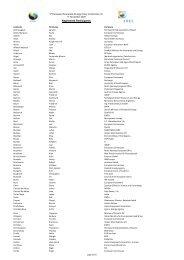
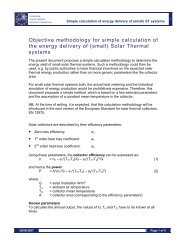
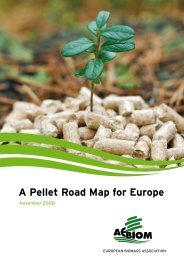
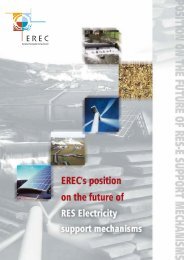

![Energy [R]evolution - Greenpeace](https://img.yumpu.com/47174859/1/184x260/energy-revolution-greenpeace.jpg?quality=85)
